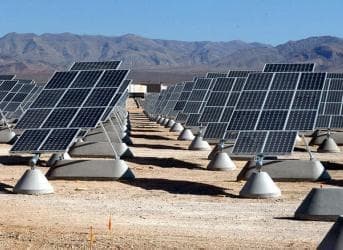Why are we even talking about Iran’s nuclear program when renewable energy offers a clear way out of this conundrum? If we can remove bad politics from the equation for a moment and get back to business as usual, energy diplomacy with Iran could render the nuclear question irrelevant altogether.
The West is not alone in the pursuit of renewable energy capacity. Middle Eastern countries are on the same path, and that includes Iran. Iran’s nuclear energy efforts were initially a reflection of the reality that oil and gas resources will not last forever. The answer to this reality was to fall back on nuclear energy, which has in turn become the focal point of a bitter conflict between Iran and the West.
But even nuclear energy is becoming yesterday’s news, both because of the push to harness renewable energy sources and also as a result of nuclear disasters, most recently that in Fukushima—which very clearly demonstrated the inability to protect nuclear facilities from Mother Nature.
Helping Iran to shift to the development of renewable energy resources would gradually remove all justification and necessity for a nuclear energy program, not the least because nuclear energy is the purview of states rather than private corporations, so there is money to be made.
That Iran is keen to pursue renewable energy efforts is clear enough. In May this year, Iranian President Mahmoud Ahmadinejad approved the allocation of €500 million from the €35 billion National Development Fund for renewable energy projects. The money is earmarked for loans for smaller developers. This purpose of the National Development Fund is to ensure that oil and gas revenues are reinvested in social development projects, with renewable energy playing a growing role.
Also supporting the solar industry is the state-sponsored Renewable Energy Organization of Iran (SUNA), which is attached to the Energy Ministry and enjoys a budget of around $60 million.
In 2010, the Iranian government announced plans to build 2,000MW of renewable energy capacity over the next five years. As of that same year, Iran had 8,500MW of hydroelectric capacity and 130MW of wind energy capacity. Iranian officials also said at the time that private companies had signed contracts to build more than 600MW of biomass systems and 500MW of new wind energy projects.
Iran is also working to make renewable energy commercially viable and the Ministry of Energy is required to buy privately produced renewable energy at world market prices. A feed-in-tariff (FiT) for wind and biomass energy of around 13 cents/kWh also helps.
Renewable energy is essential to Iran as it will curb massive pollution and increase the country’s ability to export oil and gas. Currently, the cost of fuel for producing electricity for domestic consumption and for exporting oil and gas is unsustainable in the long term.
Iran has vast untapped solar, wind, geothermal and hydroelectric sources that hold the potential to meet domestic needs and boost export capacity, and in the process make nuclear energy irrelevant. To do this, it will require massive investments.
Sanctions are not only costly to Iran, they are devastating to much of the world, and particularly to the European Union, whose decision to slap its own new sanctions on Iran in July was a political response to Israel—a response intended to steady the Israeli trigger finger poised to attack Iran. Europe cannot afford these sanctions. Investment in renewable energy technology and development would benefit all financially, geopolitically and in terms of energy independence.
The one potentially productive aspect of sanctions against Iran is that they may boost Iran’s renewable energy efforts. Earlier this year, Iranian officials hinted at just that, with the country’s energy minister calling for increased investment in renewable energy as a path forward in the face of less-than finite fossil fuels supplies and the sanctions regime.
"Gradual reduction of oil consumption on the one hand and a revolutionary and swift move toward using renewable energies on the other hand are the only appropriate mechanisms which can help the country," Iranian news agencies quoted the minister as saying in a statement delivered to the National Energy Conference in southern Iran.
ADVERTISEMENT
For those who ask why we should do business with the “enemy”, consider this: We did business with the Soviet Union for four decades of Cold War, and with Iran during its war with Iraq.
By. Charles Kennedy for Oilprice.com



















The Stalinists were not nearly as bellicose as the Iranian are...
And then examine the "business" America did with the USSR - why these trade aggregates are simply laughable..
From November of 1987:
"Carey: I think the Soviet reforms overall, not just the joint venture law, but the whole complex of economic reforms for foreign trade and otherwise will alter East-West trade relations dramatically. I think the opportunities in the Soviet Union today are at least twice what they were during detente, and that was estimated at anywhere between $5 and $7 billion in two-way trade. I think we are talking about between $10 and $15 billion and probably higher where we limp along now with roughly $2 billion in two-way trade. So, I think the opportunities are immense. If the U.S. doesn't get in there, the West Europeans will or the Japanese."
Back, back to the USSR; after all what can a Gulag produce?
Mahmood Khaghani - a retired high ranking Iranian oil industry official was making the same point in 'Asia Times' the other day
http://www.atimes.com/atimes/Middle_East/NH28Ak03.html
As for the previous commenters, anyone who has actually been there will know that Iran now is no more radically Islamic than Russia was radically Communist under Yeltsin.
There's a bigger threat going on here than weapons, it's the idea that a middle eastern country might just be developing incredibly powerful clean energy source that will wipe our oil needs off the map.
That's more scary to the powers that be.